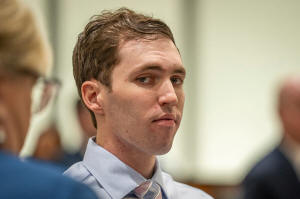Defendant in Charlie Kirk's killing asks judge to disqualify prosecutors
[January 16, 2026]
By HANNAH SCHOENBAUM and MATTHEW BROWN
SALT LAKE CITY (AP) — The 22-year-old Utah man charged with killing
conservative activist Charlie Kirk is due back in court Friday as his
attorneys seek to disqualify prosecutors in the case over an alleged
conflict of interest.
Tyler Robinson is charged with aggravated murder in Kirk's Sept. 10
shooting on the Utah Valley University campus in Orem, just a few miles
north of the Provo courthouse. Prosecutors with the Utah County
Attorney's Office plan to seek the death penalty if Robinson is
convicted. Robinson has not yet entered a plea.
An 18-year-old child of a deputy county attorney attended the campus
event where Kirk was shot. The child, whose name was redacted from court
filings, later texted with their father in the Utah County Attorney's
Office to describe the chaotic events around the shooting, the filings
from prosecutors and defense lawyers state.
Defense attorneys say that personal relationship is a conflict of
interest that “raises serious concerns about past and future
prosecutorial decision-making in this case,” according to court
documents. They also argue that the “rush” to seek the death penalty
against Robinson is evidence of “strong emotional reactions” by the
prosecution and merits the disqualification of the entire team.
Several thousand people attended the outdoor rally where Kirk, a
co-founder of Turning Point USA who helped mobilize young people to vote
for President Donald Trump, was shot as he took questions from the
audience. The child of the deputy county attorney did not see the
shooting, according to an affidavit submitted by prosecutors.

“While the second person in line was speaking with Charlie, I was
looking around the crowd when I heard a loud sound, like a pop. Someone
yelled, ‘he’s been shot,’” the child stated in the affidavit.
The child later texted a family group chat to say “CHARLIE GOT SHOT.” In
the aftermath of the shooting, the child did not miss classes or other
activities, and reported no lasting trauma “aside from being scared at
the time,” the affidavit said.
Prosecutors have asked District Judge Tony Graf to deny the
disqualification request.
[to top of second column]
|

Tyler Robinson, who is accused of fatally shooting Charlie Kirk,
appears during a hearing in Fourth District Court in Provo, Utah,
Dec. 11, 2025. (Rick Egan/The Salt Lake Tribune via AP, Pool, File)

“Under these circumstances, there is virtually no risk, let alone a
significant risk, that it would arouse such emotions in any
father-prosecutor as to render him unable to fairly prosecute the
case,” Utah County Attorney Jeffrey Gray said in a filing.
Gray also said the child was “neither a material witness nor a
victim in the case” and that “nearly everything” the person knows
about the actual homicide is mere hearsay.
The Associated Press left email and telephone messages for
Robinson's defense attorney, Kathryn Nester.
Prosecutors have said text messages and DNA evidence connect
Robinson to the killing. Robinson reportedly texted his romantic
partner that he targeted Kirk because he “had enough of his hatred.”
At recent hearings, Robinson’s legal team has pushed to limit media
access in the high-profile case. Graf has prohibited media from
publishing photos, videos and live broadcasts that show Robinson's
restraints to help protect his presumption of innocence before a
trial.
The judge has not ruled on a suggestion by the defense to ban
cameras in the courtroom.
Prosecutors are expected to lay out their case against Robinson at a
preliminary hearing scheduled to begin May 18.
___
Brown reported from Billings, Montana.
All contents © copyright 2026 Associated Press. All rights reserved
 |